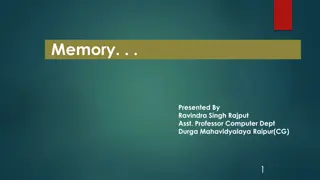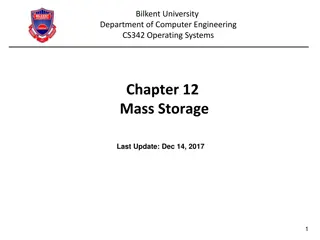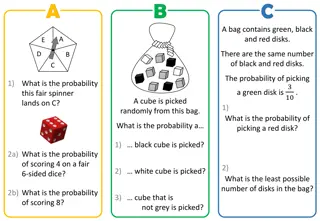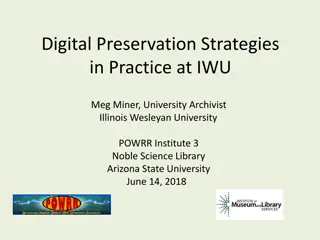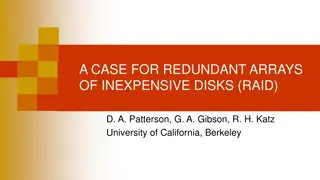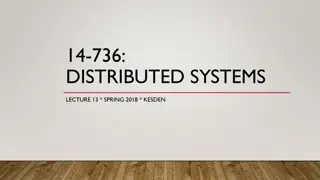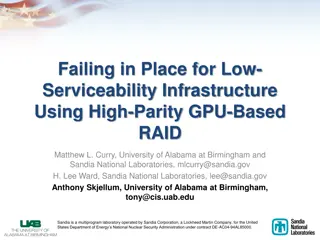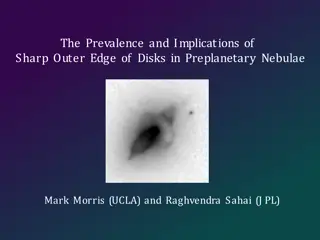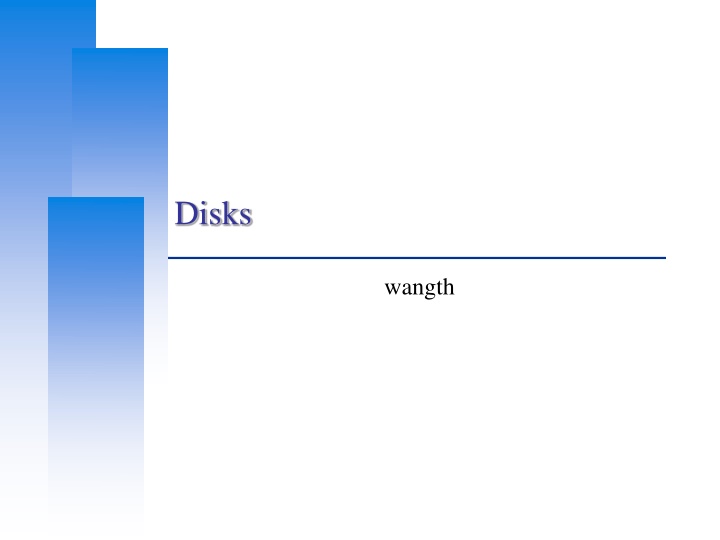
Disk Interfaces and Geometry in Computer Systems
Explore the intricacies of disk interfaces and geometry in computer systems at the Computer Center, CS, NCTU. Learn about SCSI, IDE, SATA, USB interfaces, disk installation procedures, RAID technology, and more to enhance performance and reliability. Delve into disk geometry, including sector, track, cylinder, and data block structures. Gain insights into ATA, SATA, and USB interfaces along with converters and data transfer mechanisms. Unravel the complexities of disk storage capacity calculations and the difference between gigabytes and gibibytes.
Download Presentation

Please find below an Image/Link to download the presentation.
The content on the website is provided AS IS for your information and personal use only. It may not be sold, licensed, or shared on other websites without obtaining consent from the author. If you encounter any issues during the download, it is possible that the publisher has removed the file from their server.
You are allowed to download the files provided on this website for personal or commercial use, subject to the condition that they are used lawfully. All files are the property of their respective owners.
The content on the website is provided AS IS for your information and personal use only. It may not be sold, licensed, or shared on other websites without obtaining consent from the author.
E N D
Presentation Transcript
Disks wangth
Computer Center, CS, NCTU Outline Interfaces Geometry Add new disks Installation procedure Filesystem check Add a disk RAID GEOM 2
Computer Center, CS, NCTU Disk Interfaces Expensive! SCSI Card ~ 10k SCSI Small Computer Systems Interface High performance and reliability IDE (or ATA) Integrated Device Electronics (or Advanced Technology Attachment) Low cost Become acceptable for enterprise with the help of RAID technology SATA Serial ATA SAS Serial Attached SCSI USB Universal Serial Bus Convenient to use Low Price! Enhancement Speeds up! 3
Computer Center, CS, NCTU Disk Interfaces ATA & SATA ATA (AT Attachment) ATA2 PIO, DMA LBA (Logical Block Addressing) ATA3, Ultra DMA/33/66/100/133 ATAPI (ATA Packet Interface) CDROM, TAPE Only one device can be active at a time SCSI support overlapping commands, command queuing, scatter- gather I/O Master-Slave 40-pin ribbon cable SATA Serial ATA SATA-1 1.5Gbit/s, SATA-2 3Gbit/s, SATA-3 6GBit/s SATA 3.1, SATA 3.2 16Gbit/s, SATA 3.3, eSATA, mSATA Primary Master (0) / Slave (1) Secondary Master (2) / Slave (3) 4
Computer Center, CS, NCTU Disk Interfaces ATA & SATA Interfaces ATA interface and it s cable Data Power SATA interface and it s cable Data Power 5
Computer Center, CS, NCTU Disk Interfaces USB IDE/SATA to USB Converters 6
Computer Center, CS, NCTU Disk Geometry (1) Like CDs.. Sector Track Cylinder Position Individual data block circle circle on all platters CHS: Cylinder, Head (0, 1, ), Sector 7
Computer Center, CS, NCTU Disk Geometry (2) 40G HD 4866 cylinders, 255 heads 63 sectors per track, 512 bytes per sector 512 * 63 * 4866 * 255 = 40,024,212,480 bytes G M K 1KB = 1024 bytes 1MB = 1024 KB = 1,048,576 bytes 1GB = 1024 MB = 1,073,741,824 bytes Why? 40,024,212,480 / 1,073,741,824 37.275 GB 10^3 vs. 2^10 8
Disk Installation Procedure (in BSD )
Computer Center, CS, NCTU Disk Installation Procedure (1) The procedure involves the following steps: Connecting the disk to the computer IDE: master/slave SATA SCSI: ID, terminator power Creating device files Auto created by devfs Please do it offline Meta data a HD data Format (metadata + data) v.s. fast format (metadata only) Formatting the disk Low-level format Manufacturer diagnostic utility Kill all address information and timing marks on platters Repair bad sectors mark the bad sectors and don t use them! 10
Computer Center, CS, NCTU Disk Installation Procedure (2) Partitioning (and Labeling) the disk) Allow the disk to be treated as a group of independent data area e.g. root, home, swap partitions Former Suggestions: /var, /tmp separate partition (for backup issue) Make a copy of root filesystem for emergency Establishing logical volumes Combine multiple partitions into a logical volume Related to RAID Software RAID technology GEOM: geom(4) geom(8) ZFS: zpool(8) zfs(8) zdb(8) 11
Computer Center, CS, NCTU Disk Installation Procedure (3) Creating UNIX filesystems within disk partitions Use newfs to install a filesystem for a partition Establish all filesystem components A set of inode storage cells A set of data blocks A set of superblocks A map of the disk blocks in the filesystem A block usage summary 12
Computer Center, CS, NCTU Disk Installation Procedure (4) Superblock contents The length of a disk block Inode table s size and location Disk block map Usage information Other filesystem s parameters sync The sync() system call forces a write of dirty (modified) buffers in the block buffer cache out to disk. The sync utility can be called to ensure that all disk writes have been completed before the processor is halted in a way not suitably done by reboot(8) or halt(8). 13
Computer Center, CS, NCTU Disk Installation Procedure (5) mount Bring the new partition to the filesystem tree mount point can be any directory (empty) # mount /dev/ad1s1e /home2 Setting up automatic mounting Automount at boot time /etc/fstab % mount -t ufs /dev/ad2s1a /backup % mount -t cd9600 -o ro,noauto /dev/acd0c /cdrom liuyh@NASA:/etc> cat fstab # Device Mountpoint /dev/ad0s1b none /dev/ad2s1b none /dev/ad0s1a / /dev/acd0 /cdrom /dev/ad2s1a /backup csduty:/bsdhome /bsdhome ad1 s1 d e f partition, newfs Mount CD Also for ISO image file Fstype swap swap ufs cd9660 ufs nfs Options sw sw rw ro,noauto rw,noauto rw,noauto Dump 0 0 1 0 2 0 Pass# 0 0 1 0 2 0 Usually: 2, 1 for root; No write = 0 Mount from the network; talk about it in NFS 14
Computer Center, CS, NCTU Disk Installation Procedure (6) Setting up swapping on swap partitions swapon, swapoff, swapctl # swapon -a mount all partitions for swap usage swapinfo, pstat nctucs [~] -wangth- swapinfo Device 1K-blocks Used Avail Capacity /dev/da0p2 2097152 42772 2054380 2% 15
Computer Center, CS, NCTU fsck check and repair filesystem (1) System crash will cause Inconsistency between memory image and disk contents fsck Examine all local filesystem listed in /etc/fstab at boot time. (fsck -p) Automatically correct the following damages: Unreferenced inodes Inexplicably large link counts Unused data blocks not recorded in block maps Data blocks listed as free but used in file Incorrect summary information in the superblock fsck(8) fsck_ffs(8) ffsinfo(8): dump metadata Check if filesystem is clean 1: clean (ro) 0: dirty (rw) 16
Computer Center, CS, NCTU fsck check and repair filesystem (2) No guarantee on fully recover you HD Run fsck in manual to fix serious damages Blocks claimed by more than one file Blocks claimed outside the range of the filesystem Link counts that are too small Blocks that are not accounted for Directories that refer to unallocated inodes Other errors fsck will suggest you the action to perform Delete, repair, 17
Computer Center, CS, NCTU Adding a disk to FreeBSD (1) 1. Check disk connection > Look system boot message ada3: 238475MB <Hitachi HDS722525VLAT80 V36OA6MA> at ata1-slave UDMA100 Line, speed 2. Use gpart(8) to create a partition on the new HD > # gpart create -s GPT ada3 > # gpart add -t freebsd-ufs -a 1M ada3 Use newfs(8) to construct new UFS file system > # newfs -U /dev/ada3p1 Make mount point and mount it > # mkdir /home2 > # mount -t ufs /dev/ada3p1 /home2 > # df Edit /etc/fstab 3. 4. 4. https://www.freebsd.org/doc/handbook/disks-adding.html 18
Computer Center, CS, NCTU Adding a disk to FreeBSD (2) If you forget to enable soft-update when you add the disk % umount /home2 % tunefs -n enable /dev/ada3p1 % mount -t ufs /dev/ada3p1 /home2 % mount /dev/ada0p2 on / (ufs, local, soft-updates) /dev/ada1p1 on /home (ufs, local, soft-updates) procfs on /proc (procfs, local) /dev/ada3p1 on /home2 (ufs, local, soft-updates) https://www.freebsd.org/doc/handbook/configtuning-disk.html 19
GEOM Modular Disk Transformation Framework
Computer Center, CS, NCTU GEOM (1) Support ELI geli(8): cryptographic GEOM class JOURNAL gjournal(8): journaled devices LABEL glabel(8): disk labelization MIRROR gmirror(8): mirrored devices STRIPE gstripe(8): striped devices Journalize (logs) before write Software RAID1 Software RAID0 http://www.freebsd.org/doc/handbook/geom.html 21
Computer Center, CS, NCTU GEOM (2) GEOM framework in FreeBSD Major RAID control utilities Kernel modules (/boot/kernel/geom_*) Name and Prodivers manual or automatic Metadata in the last sector of the providers volumes devices Logical Kernel support {glabel,gmirror,gstripe,g*} load/unload device GEOM_* in kernel config geom_*_enable="YES" in /boot/loader.conf (1) On demand load/unload kernel modules load automatically at booting (2) Build-in kernel and recompile 22
Computer Center, CS, NCTU GEOM (3) Why use it? bundle by name instead of bundle by provider LABEL Used for GEOM provider labelization Kernel device GEOM_LABEL geom_label_load="YES" glabel (for new storage) # glabel label -v usr da2 # newfs /dev/label/usr # mount /dev/label/usr /usr # glabel stop usr # glabel clear da2 UFS label (for an using storage) # tunefs -L data /dev/da4s1a # mount /dev/ufs/data /mnt/data e.g. ad0s1d usr glabel label Create permanent labels glabel create Create transient labels /dev/label/usr Stop using the name Clear metadata on provider data is a name 23
Computer Center, CS, NCTU GEOM (4) MIRROR Kernel device GEOM_MIRROR geom_mirror_load="YES" gmirror # gmirror label -v -b round-robin data da0 # newfs /dev/mirror/data # mount /dev/mirror/data /mnt # gmirror insert data da1 # gmirror forget data # gmirror insert data da1 # gmirror stop data # gmirror clear da0 logical volume called data , using HD: da0, Add in HD Kill inexist HDs 24
Computer Center, CS, NCTU GEOM (5) STRIPE Kernel device GEOM_STRIPE geom_stripe_load="YES" gstripe # gstripe label -v -s 131072 data da0 da1 da2 da3 # newfs /dev/stripe/data # mount /dev/stripe/data /mnt # gstripe stop data # gstripe clear da0 Create logical volume data , which stripe da0~da3 HDs 25
Computer Center, CS, NCTU RAID (1) Redundant Array of Inexpensive Disks A method to combine several physical hard drives into one logical unit Depending on the type of RAID, it has the following benefits: Fault tolerance Higher throughput Real-time data recovery RAID Level RAID 0, 1, 0+1, 2, 3, 4, 5, 6 Hierarchical RAID RAID0 e.g. HD1, HD2 D:\ in windows RAID1 - RAID0 - HD - HD - HD - RAID0 - HD - HD - HD RAID1 RAID0 27
Computer Center, CS, NCTU RAID (2) Hardware RAID There is a dedicate controller to take over the whole business RAID Configuration Utility after BIOS Create RAID array, build Array Software RAID GEOM CACHE CONCAT ELI MULTIPATH NOP VIRSTOR ZFS JBOD STRIPE MIRROR RAID-Z RAID-Z2 RAID-Z3 JOURNAL PART RAID3 LABEL SHSEC MIRROR STRIPE 28
Computer Center, CS, NCTU RAID 0 (normally used) (500GB+500GB=1TB) Stripped data intro several disks Minimum number of drives: 2 Advantage Performance increase in proportional to n theoretically Simple to implement Disadvantage No fault tolerance Recommended applications Non-critical data storage Application requiring high bandwidth (such as video editing) e.g. HD1 (500GB), HD2 (500GB) D:\ in windows (1TB) parallel file io from/to different HDs 29
Computer Center, CS, NCTU RAID 1 (normally used) (500GB+500GB=500B) Mirror data into several disks Minimum number of drives: 2 Advantage 100% redundancy of data Disadvantage 100% storage overage Moderately slower write performance Recommended application Application requiring very high availability (such as home) Cause by double check mechanisms on data 30
Computer Center, CS, NCTU RAID 0+1 (normally used) [(500GB+500GB)+(500GB+500GB)]=1TB) Combine RAID 0 and RAID 1 Minimum number of drives: 4 RAID1, RAID1 Them RAID0 above it 31
Computer Center, CS, NCTU RAID 2 Hamming Code ECC Each bit of data word Advantages: "On the fly" data error correction Disadvantages: Inefficient Very high ratio of ECC disks to data disks Recommended Application No commercial implementations exist / not commercially viable Read, check if correct, then read 32
Computer Center, CS, NCTU RAID 3 RAID1 if two HDs Save parity Parallel transfer with Parity Minimum number of drives: 3 Advantages: Very high data transfer rate Disadvantages: Transaction rate equal to that of a single disk drive at best Recommended Application Any application requiring high throughput 33
Computer Center, CS, NCTU RAID 4 Similar to RAID3 RAID 3 V.S RAID 4 Byte Level V.S Block Level Block interleaving Small files (e.g. 4k) Block normally 512bytes (4k for WD HDs) 34
Computer Center, CS, NCTU RAID 5 (normally used) Independent Disk with distributed parity blocks Minimum number of drives: 3 Advantage Highest read data rate Medium write data rate Disadvantage Disk failure has a medium impact on throughput Complex controller design When one disk failed, you have to rebuild the RAID array Origin from RAID3 Parallel file I/O Can tolerate only 1 HD failure 35
Computer Center, CS, NCTU RAID 6 (normally used) Similar to RAID5 Minimum number of drives: 4 2 parity checks, 2 disk failures tolerable. Slower than RAID5 because of storing 2 parities 36


